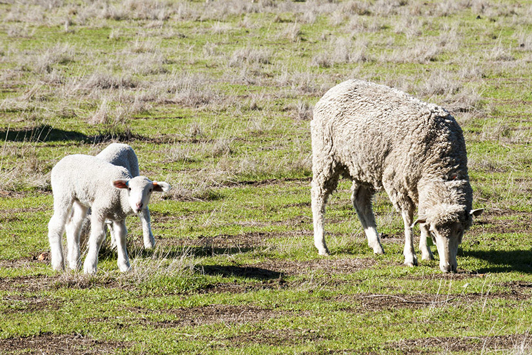How to use the calculator
To get started, enter the flock details, and use the slider bar to set the proportion of singles, twins and dry ewes.
Number of sheep
Enter the flock size for the paddock.
Frame size
Frame size or standard reference weight (SRW) is the weight of a dry adult sheep in good condition (condition score 3). The SRW is determined by the genotype of your flock. Select the size that best fits the average of the flock.
Status
Feed intake and energy requirements change with the state of pregnancy and lactation.
Day 0 is when the rams went in. Day 150 is lambing.
Dry, single, twins
Enter the proportion of the flock as single bearing, twin bearing, or dry. You can use the estimated proportions for a 120% reproductive rate as: 10% dry, 60% singles, and 30% twins. These fields must add up to 100%.
The most accurate data is provided by pregnancy scanning undertaken by a competent contractor. If pregnancy scanning data is not available, use the Pregnancy scanning benchmarks tool to see what reproductive rates are like your enterprise type.
Current condition score (CS)
Enter the average condition score for the flock. Average condition score can be done on 25-50 sheep randomly selected from a mob.
For descriptions and pictures of condition scoring, see the Condition scoring of sheep webpage, linked at the end of this page.
Target condition score
This is the condition score you want the flock to have reached by the target time. A lower target condition score in relation to the current condition score means the sheep will lose condition. A higher target condition score will mean the sheep will gain condition.
Sheep can gain weight up to 200 grams/head/day and should not be allowed to lose more than 100 grams/head/day. The calculator will not let you choose a condition score change that is too significant for a given period.
Target time
This is the period between CS assessments of the flock. When pasture is growing quickly, or weather is changeable, it is important to reassess CS more frequently. More regular assessments should also be made as ewes move into late pregnancy and lactation when their energy requirements rapidly change. It will take at least a couple of weeks to see changes in CS unless ewes are rapidly losing weight.
Enter the appropriate quantity in grams/head/day of the selected feeds you are currently feeding your flock.
Paddock area
Enter the arable or grazing area of the paddock.
Present feed on offer (FOO)
Enter the amount of green feed on offer (herbage mass) in kilograms of dry matter per hectare (kg/DM/ha) presently in the paddock. If ewes are in confinement, set present FOO to 0 kg DM/ha.
For information and a video link on how to estimate FOO in the paddock, see the Annual pasture quantity and quality in South West Western Australia webpage, linked at the end of this page.
Clover % in pasture
The amount of clover in the pasture affects the quality of the pasture and the feed intake of sheep because clover tends to be shorter than grasses. Choose the level most like the average of the paddock.
Pasture growth rate
Enter the growth rate of pasture in your paddock. Average pasture growth rate (PGR) values for your area can be found at the Pastures from Space website, in weekly time steps.
Feed type
Select the type of supplementary feed from the drop-down lists presented. You can select feed type A as your primary feed and, if required, a secondary feed as type B. For more information on supplementary feeding, see the Supplementary feeding and feed budgeting for sheep webpage, linked below.
Energy
This is the energy (megajoules) of the feed selected. This figure is given ‘as fed’, which means it considers the moisture % of the feed. For more information on the different values of sheep feeds, see the Sheep feed value guide, linked below.
A default value is given for the feed type you have selected. If you have tested your feed, select the ‘Own values’ button to enter the actual energy level of the feed and remember to use the ‘as fed’ values.
Composition of feed
The mix ratio of the new feed types, split by weight.
Note: This calculator was developed using the best available data for sheep grazing annual legume-based pastures.

